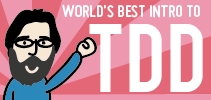Agile's Hyperproductivity X-Prize
First reported on April 1, 2014. Markham, Ontario, Canada.
IBM has reached yet another frontier in software engineering. Although Scrum has promised hyperproductive teams for over a decade, a small group of dedicated programmers, testers, and one visionary project manager have discovered the secrets of hypoproductivity. Housed in IBM’s spacious offices north of Toronto, Canada, Michael Rabinsky leads a team that has met goals independently raised by the #NoEstimates movement: they have transcended velocity and productivity. “Other groups use Scrum to increase productivity, pushing their burn-up charts, trying to accelerate towards hyperproductivity. I… well, we found the software project equivalent of a wormhole. I long suspected it existed, and one Tuesday afternoon, while playing ping-pong on the fourth floor, it came to me.”
Rabinsky remembered a quirk of working at IBM. “You see, everyone who works here has a number. That number represents how long they can go without producing any real results before someone notices and they get fired. They still appear busy, they show up at meetings, they send emails, but it can take weeks, months, even years before it becomes a big-enough problem for their bosses to want them fired. See that guy in the corner, there? His number has made it up to about 27 years. When I saw him that afternoon in the lounge quietly reading a book in the corner, I realized: if I gathered 4-6 people whose numbers measured in the decades, then I would have the ultimate high-leverage team: they would produce absolutely nothing with effectively zero risk of losing their jobs.”
“That,” Rabinsky told me dramatically, “is the essence of hypoproductivity. We’ve living the dream. Thanks, Ken.” Rabinsky refers to Ken Schwaber, thought to be the first Scrum proponent to reveal the promise of hyperproductivity.
Other teams, in order to achieve hypoproductivity, have had to take the long route. “First, they accelerate their productivity. Scrum makes that easy. Then their velocity tends towards infinity. You might need a little XP for that. Finally, you need your velocity to wrap around from positive infinity to negative infinity, to go from perfect hyperproductivity to perfect hypoproductivity. That’s where my… our wormhole comes in. I… we jumped straight to hypoproductivity, and I think that in the next few years, we’ll achieve literal, perfect, negative infinity velocity—they’ll keep paying us, even though we’re gradually causing all of IBM to collapse on itself.”
Turning to the whiteboard behind him, Rabinsky added, “That burn-down chart has us getting there sometime between 2Q2016 and the 2030s. Cross your fingers!”
This startling breakthrough has given Rabinsky and his team a shot at winning the long-sought-after John Goodsen prize, which includes a million-dollar prize and a lifetime supply of high-quality, single-malt scotch for the entire team. This prize was established in 2004 to support cutting-edge research into hypoproductivity. There are, however, rumors of a group within British Telecom coming dangerously close to a similar breakthrough.


